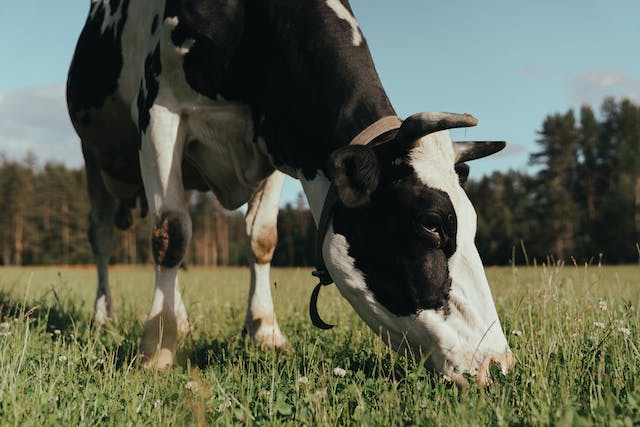
Do cows only eat grass? Wild cows and cows that graze on pasture eat a lot of grass, but they also eat other plants as well. Cows that are kept in dairy farms are often fed a lot of grain and soy.
There are not many wild cows in the world. In most developed countries, they are only kept on farms. Some African countries, India, and some Asian countries do have wild cows, but there are far more domestic cows in the world than wild cows. Humans domesticated the cow about 10,500 years ago. The first cows were probably wild oxen and genetic studies have shown that all cattle are descended from those early oxen. The first animals were very large and probably quite dangerous. Humans had to breed them to be smaller and more docile. Cows were kept for their meat and their leather in the beginning. We didn’t start milking them until about two thousand years later.
Cows that are kept on pastures appear to only be eating grass, but they are actually eating a wide variety of plants and herbs. They can get different nutrients, vitamins, and minerals from different plants, so they eat a lot of different things. They also instinctively know what their body is lacking and what they need to eat. They have an excellent memory for plants and they can remember where they grow and what they do. If you leave cows to graze in a wild field, they will eat a very balanced diet. However, they lack salt, as do many herbivores. Salt is vital for any mammal, so they have to get it somehow. Farmed cows are given a block of salt to lick, but wild cows have to find a natural salt deposit.
When farmers want to raise grass fed cows, they have to think about the plants on their pasture. Different plants have different nutritional content depending on the time of year, the soil they grow on, and the climate. A good pasture will have types of legumes, such as clover, lentils, alfalfa, and beans. These plants have a higher protein level than grass. Wild cows and pasture cows do sometimes eat grain as well. In the winter, or when there is a drought, cows will find seeds, which is grain. Farmers will give cows grain in the winter when the grass is not growing. They can also be fed on silage, which is a combination of grasses and legumes that were harvested and allowed to ferment. Because they are slightly fermented, they are partially broken down and the cows can get the energy out of them much more easily. Cows can also be fed straw through the winter, which is dried grass, but it has a lower protein and nutritional content than fresh grass, so the cows need to be fed supplements as well.
Recently, dairy cows and factory farmed cows are fed a lot of corn and soybeans. Soybeans are produced in areas that have been cleared of rainforest. They are cheap to grow, and they are made into feed for cows. They are cheap, but it is an unsustainable industry and a diet of only soy is not good for the cows.
How are cows able to get the energy out of grass? The first thing is they have very thick and rough tongues because grass can be sharp. They also have teeth that never stop growing. Grass has a lot of fiber, which is very hard to chew and cow’s teeth wear down. Their teeth never stop growing so they can always eat. However, the real reason they can eat grass comes down to their stomachs.
Cows have four stomachs that all have a different purpose. They also have a lot of bacteria that help them to digest grass. First cows eat as much grass as they can fit in their rumen, which is their first stomach. The rumen can absorb some nutrients, but most of the grass and plant matter is still undigested. The cows regurgitate it back into their mouths so they can chew it more, before swallowing it again. There are millions of bacteria living in the reticulum that can ferment and break down the cellulose in the plant matter. The rumen is attached to the second stomach, the reticulum. This has a similar function and food is constantly regurgitated from these for more chewing. Altogether, they can hold about 120 liters of food. The third stomach is the omasum and it absorbs water and nutrients from the food that has finished being chewed and broken down by bacteria. The fourth stomach is the abomasum and this is where stomach acids and enzymes are released to continue digesting the plant matter. The food then goes into the intestines. All of these parts of the cow’s digestive tract are the reason why they can get a lot of energy and nutrients out of grass and plants. And this is what I learned today.
Photo by cottonbro studio: https://www.pexels.com/photo/black-and-white-cow-on-green-grass-field-4919685/
Sources
https://www.worldanimalprotection.us/blogs/what-do-cows-eat
https://www.quora.com/Where-do-cows-goats-and-other-large-herbivores-get-their-sodium-from
https://www.animalsasia.org/au/education/education-archive/one-life-cows.html
https://www.fda.gov/animal-veterinary/animal-health-literacy/how-cows-eat-grass
